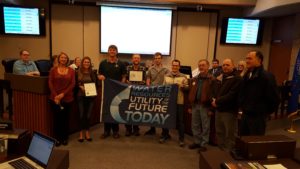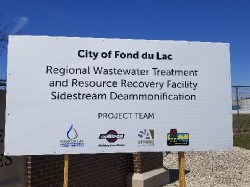Utility of the Future

The Fond du Lac Wastewater Treatment & Resource Recovery Facility, named a 2016 Utility of the Future by the Water Environment Federation, has explored a multitude of pilot and full-scale phosphorus removal technologies/chemicals in an effort to evaluate how to meet their upcoming Water Quality Based Effluent Limits (WQBEL) of 0.04 mg/L P for final effluent discharge. In addition to exploring effluent phosphorus removal, we will be constructing and installing a deammonification system in 2017 and have plans for nutrient harvesting and biosolids drying in the future.
The Fond du Lac Regional Wastewater Treatment & Resource Recovery Facility is addressing the challenges of nutrient discharge into Lake Winnebago. As a “point source,” WTRRF is among the wastewater utilities which will face stricter environmental regulations on phosphorus discharge into receiving waters. WTRRF has been conducting research for the most economical and cost effective approach to meet these new requirements, in lieu of spending millions to upgrade our plant.
 Sidestream Deammonification Project
Sidestream Deammonification Project
Ground was broken in April 2018 for the Sidestream Deammonification project.
Liquid streams, known as sidestreams, generated by the dewatering of digested sludge contain elevated nutrient concentrations. Sidestream nitrogen loads from wastewater treatment plants can account for 15-20 percent of influent nitrogen.
This project will help us meet the increasing demand for lower nutrient effluents and increasing desire to reduce operating costs such as energy, chemicals, and maintenance.
“Cost-effective, sustainable removal of ammonium from effluents and ammonia from waste gas”
The ANAMMOX® process is a cost-effective and sustainable way of removing ammonium from effluents and ammonia from waste gas. Compared to conventional nitrification/denitrification savings on operational costs can reach up to 60%, while CO2 emission is reduced.
The ANAMMOX® conversion is an elegant shortcut in the natural nitrogen cycle. Anammox bacteria convert ammonium (NH4+) and nitrite (NO2–) into nitrogen gas. Paques developed the process for commercial purposes in cooperation with Delft University of Technology and the University of Nijmegen. Since the first full-scale plant started up in 2002, many other ANAMMOX® plants were implemented worldwide.
